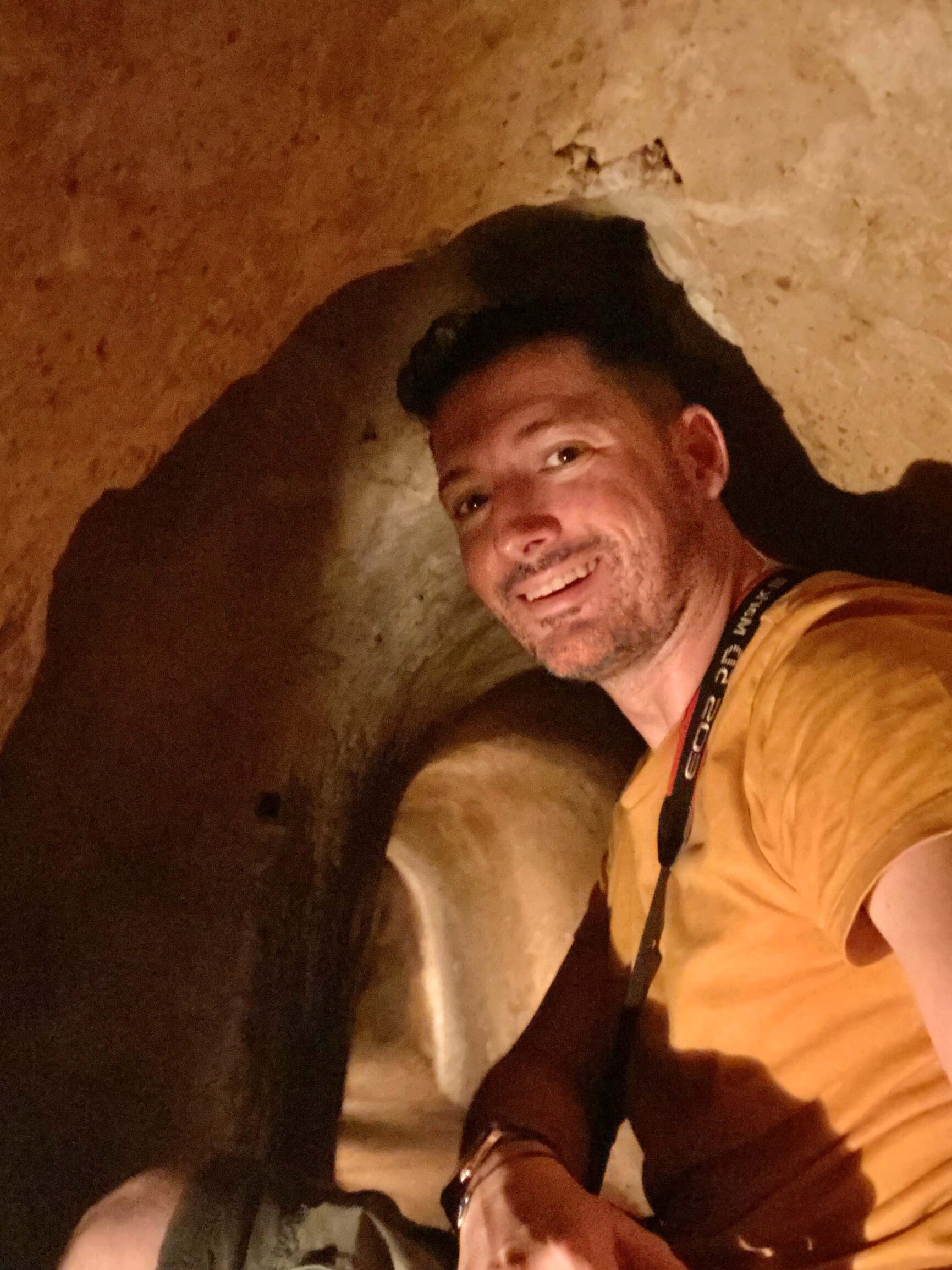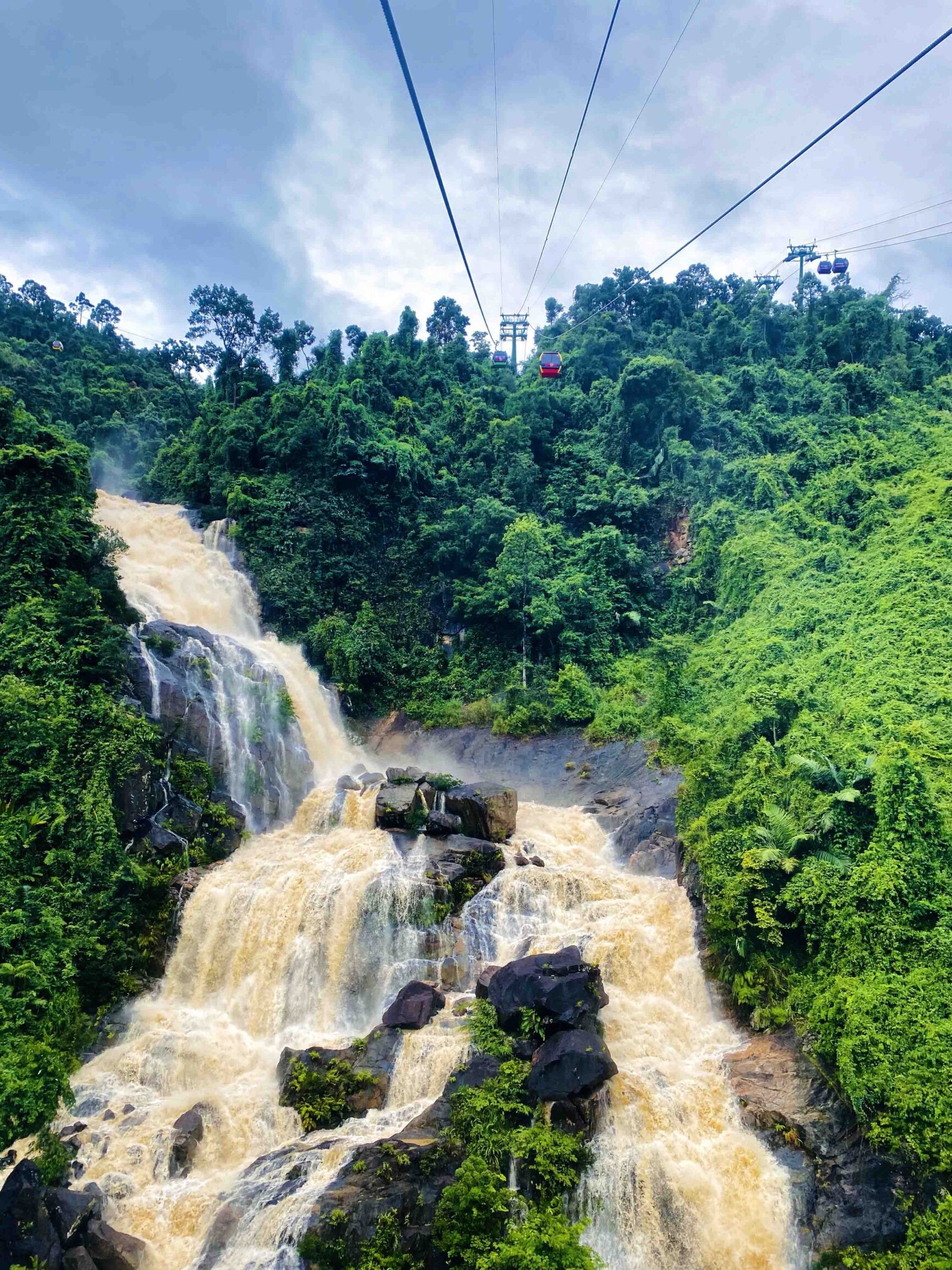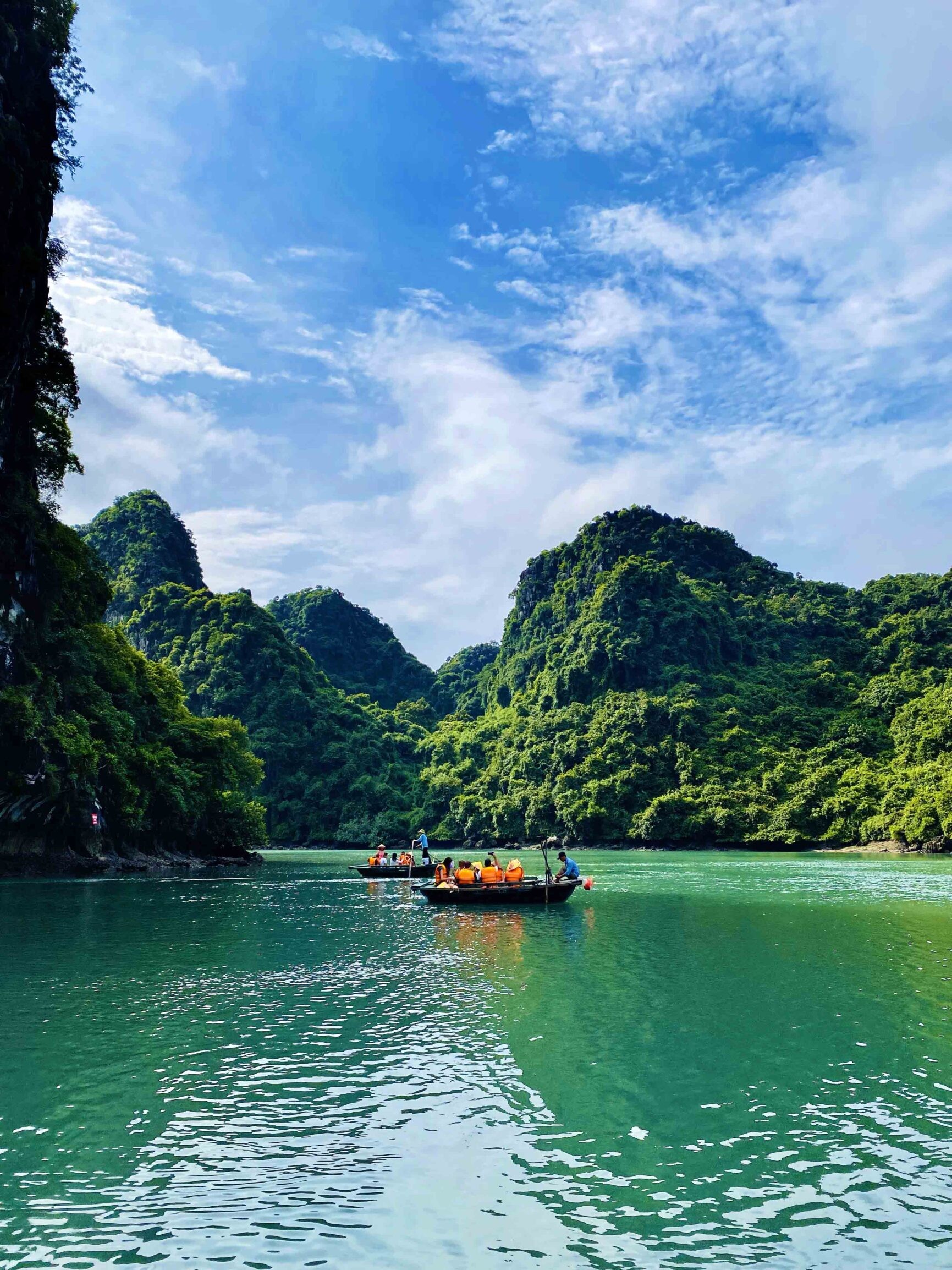Are you curious about the location of Luon Cave, often associated with streams and rivers in Vietnam? SIXT.VN is here to guide you through the enchanting landscapes of Vietnam and reveal the location of this natural wonder, offering convenient travel solutions. Let’s uncover the mystery and explore this scenic destination, offering insights into nearby attractions and travel tips for an unforgettable adventure.
1. What is Luon Cave and Why is it Famous?
Luon Cave is a captivating natural tunnel carved by water over millennia, a feature frequently linked to Vietnam’s streams and rivers. The answer to “Where is Luon Cave located?” is within the stunning Halong Bay, a UNESCO World Heritage site. Known for its unique entrance accessible only by boat, it leads into a serene, enclosed lagoon, making it a sought-after destination for tourists seeking to witness nature’s artistry. The appeal of Luon Cave lies in its tranquil beauty, the adventure of traversing its waters, and the secluded paradise it reveals, as noted by the Vietnam National Administration of Tourism, which highlights the cave as a prime example of Halong Bay’s geological and ecological splendor.
1.1. Geological Formation and Significance
Luon Cave’s geological formation tells a story of time and nature’s powerful influence. The cave was created as water eroded the limestone cliffs of Halong Bay, resulting in an archway connecting the sea to an enclosed lake. Such formations contribute to the bay’s distinctive landscape, as acknowledged by UNESCO for its exceptional geological value. According to research from the Department of Geology and Minerals of Vietnam, the limestone karsts in Halong Bay, including those that house Luon Cave, are millions of years old.
1.2. Ecological Importance
The lagoon within Luon Cave is not only a visual wonder but also an ecologically significant site. It provides a protected habitat for various marine species, contributing to the biodiversity of Halong Bay. The enclosed nature of the lagoon allows for a unique ecosystem to flourish, separate from the open sea. Studies by the Vietnam National Museum of Nature indicate that these lagoons often house endemic species, underscoring the need for conservation efforts.
1.3. Why Luon Cave Attracts Tourists
Luon Cave appeals to tourists for several reasons:
- Unique Access: The thrill of entering a cave by boat is an adventure in itself.
- Secluded Lagoon: The sense of discovering a hidden paradise is a major draw.
- Natural Beauty: The stunning scenery of the lagoon surrounded by limestone cliffs is visually captivating.
- Tranquility: The peaceful atmosphere offers a respite from the bustling tourist spots.
1.4. Cultural Significance
Aside from its geological and ecological attributes, Luon Cave has cultural importance. Local legends and stories are linked to the cave, adding a layer of mystery and intrigue for visitors. According to the Halong Bay Management Board, these stories often depict the cave as a sacred space or a gateway to another world. Exploring Luon Cave is not only a visual experience but also a cultural journey.
2. Exact Location: Where Can You Find Luon Cave?
Luon Cave is situated on Bo Hon Island, one of the many islands that make up Halong Bay, a UNESCO World Heritage Site in Quang Ninh province, Vietnam. This puts it in the heart of one of the world’s most spectacular seascapes. The cave’s coordinates are approximately 20.8933° N latitude and 107.0667° E longitude, making it easily accessible by boat from the main tourist hubs in Halong Bay. You can find the exact location on Google Maps or other navigation apps.
2.1. Detailed Geography of Bo Hon Island
Bo Hon Island is an island of ecological richness and geological diversity. Its karst topography, characterized by limestone cliffs and lush vegetation, provides a habitat for numerous plant and animal species. The island’s landscape has been shaped by millions of years of erosion and weathering, resulting in the unique formations seen today. According to a survey by the Vietnam Institute of Geosciences and Mineral Resources, Bo Hon Island is composed primarily of Carboniferous limestone.
2.2. How to Reach Luon Cave within Halong Bay
Reaching Luon Cave requires a boat trip from one of Halong Bay’s ports. Most cruises and day tours include a visit to the cave as part of their itinerary. The journey involves navigating through the bay’s emerald waters, passing by towering limestone karsts, before arriving at the cave’s entrance. Tourists often transfer to smaller bamboo boats or kayaks to enter the cave. SIXT.VN provides convenient transportation options to the ports of Halong Bay, ensuring a smooth start to your adventure.
2.3. Nearby Attractions on Bo Hon Island
Bo Hon Island is home to numerous attractions in addition to Luon Cave:
- Sung Sot Cave (Surprise Cave): One of the largest and most famous caves in Halong Bay, featuring stunning stalactites and stalagmites.
- Titop Island: Known for its sandy beach and panoramic views from the summit.
- Ho Dong Tien (Fairy Lake Cave): A smaller cave with a tranquil lake inside.
- Hang Trong (Drum Cave): Named for the drumming sound produced by the wind blowing through its stalactites.
2.4. Accessibility Considerations
While Luon Cave is a must-see destination, accessibility can be a concern for some travelers. The cave is only accessible by boat, and visitors must transfer to smaller vessels or kayaks to enter. This may pose challenges for individuals with mobility issues. It’s important to check with your tour operator about accessibility options before booking a trip. SIXT.VN can assist in arranging tours with appropriate accommodations.
3. Planning Your Visit: Tips and Recommendations
Planning a visit to Luon Cave requires careful consideration of the time of year, weather conditions, and available tours. Here are some tips and recommendations to ensure an unforgettable experience.
3.1. Best Time to Visit
The best time to visit Luon Cave is during the dry season, from October to April. During these months, the weather is pleasant with clear skies and calm seas. The peak tourist season is from December to February, so expect larger crowds and higher prices. The wet season, from May to September, can bring heavy rains and typhoons, which may disrupt boat tours. According to the Vietnam National Centre for Hydro-Meteorological Forecasting, the most stable weather conditions are typically in the months of March and April.
3.2. Choosing the Right Tour Operator
Selecting a reputable tour operator is vital to ensure a safe and enjoyable trip. Look for companies with experienced guides, well-maintained boats, and positive reviews. Check whether the tour includes entrance fees, meals, and activities such as kayaking or bamboo boat rides. SIXT.VN partners with reputable tour operators to offer a range of options to suit different budgets and preferences.
3.3. What to Bring
To make the most of your visit, bring the following items:
- Sunscreen: The sun can be intense, even on cloudy days.
- Hat: To protect yourself from the sun.
- Sunglasses: To reduce glare from the water.
- Water: Staying hydrated is essential, especially during the warmer months.
- Insect repellent: Mosquitoes and other insects can be prevalent, especially in the evenings.
- Camera: To capture the breathtaking scenery.
- Swimsuit: If you plan to swim in the lagoon.
- Waterproof bag: To protect your electronics and valuables.
3.4. Understanding Weather Conditions
Halong Bay’s weather can be unpredictable, so it’s important to check the forecast before your trip. Be prepared for sudden changes in weather conditions, such as rain or fog. In case of severe weather, boat tours may be cancelled for safety reasons. The Quang Ninh Department of Tourism provides updates on weather conditions and any potential disruptions.
4. Experiencing Luon Cave: Activities and Highlights
Visiting Luon Cave is about more than just seeing a natural wonder, it’s about immersing yourself in the beauty and tranquility of Halong Bay. Here are some activities and highlights to look forward to.
4.1. Kayaking or Bamboo Boat Ride
The most popular way to explore Luon Cave is by kayaking or a traditional bamboo boat. These smaller vessels allow you to navigate through the narrow entrance and into the serene lagoon. Kayaking gives you more independence to explore at your own pace, while a bamboo boat ride offers a relaxing experience with a local rower. The Halong Bay Management Board regulates these activities to ensure safety and environmental protection.
4.2. Observing the Wildlife
The lagoon within Luon Cave is home to a diverse range of marine life, including fish, crabs, and shrimp. Keep an eye out for monkeys climbing on the surrounding cliffs. The area is also a habitat for various bird species. Birdwatchers may spot cormorants, herons, and egrets. The Vietnam Academy of Science and Technology has conducted studies on the biodiversity of Halong Bay, highlighting the importance of preserving these ecosystems.
4.3. Photography Opportunities
Luon Cave offers photographers endless opportunities to capture stunning images. The light filtering through the cave entrance, the reflections on the water, and the lush vegetation create a visually captivating scene. Early morning and late afternoon are ideal times for photography, as the light is softer and more diffused. Be sure to bring a waterproof camera or case to protect your equipment.
4.4. Swimming in the Lagoon
Some tours allow visitors to swim in the lagoon within Luon Cave. The water is usually calm and clear, providing a refreshing experience. However, it’s important to check with your tour operator about water quality and safety regulations. Swimming may be restricted at times due to environmental concerns. The Halong Bay Management Board monitors water quality to ensure the health of the ecosystem.
5. Accommodation and Transportation: Making it Easy with SIXT.VN
SIXT.VN offers a comprehensive range of services to ensure your trip to Luon Cave and Halong Bay is seamless. From airport transfers to hotel bookings, we’ve got you covered.
5.1. Airport Transfers
Arriving at an airport in a new country can be stressful. SIXT.VN offers reliable and comfortable airport transfer services from Noi Bai International Airport (HAN) in Hanoi to Halong Bay. Our professional drivers will meet you at the airport and take you directly to your hotel or the harbor for your cruise. This service ensures a smooth transition and allows you to relax from the moment you arrive.
5.2. Hotel Recommendations
Halong Bay offers a wide range of accommodation options, from budget-friendly guesthouses to luxurious resorts. SIXT.VN can help you find the perfect hotel to suit your needs and preferences. Some popular hotels include:
- Vinpearl Resort & Spa Halong: A luxurious resort with stunning views of the bay.
- Muong Thanh Grand Halong Hotel: A modern hotel with excellent amenities and a central location.
- Novotel Halong Bay: A stylish hotel with a rooftop pool and bar.
5.3. Booking Tours and Cruises
SIXT.VN partners with reputable tour operators to offer a variety of tours and cruises to Luon Cave and Halong Bay. We can help you find the perfect itinerary, whether you’re looking for a day trip or a multi-day cruise. Our experienced travel consultants can provide personalized recommendations and assist with all your booking needs.
5.4. Local Transportation
Getting around Halong Bay is easy with SIXT.VN’s local transportation services. We offer private car rentals, taxis, and shuttle buses to help you explore the area at your own pace. Our drivers are knowledgeable about the local area and can provide valuable insights and recommendations.
6. Sustainable Tourism: Protecting Luon Cave for Future Generations
As tourism grows in Halong Bay, it’s important to practice sustainable tourism to protect the natural environment. Here are some ways to minimize your impact and contribute to the conservation of Luon Cave and the surrounding area.
6.1. Minimizing Environmental Impact
Reduce your environmental impact by following these tips:
- Avoid single-use plastics: Bring a reusable water bottle and shopping bag.
- Dispose of waste properly: Use designated trash cans and avoid littering.
- Respect wildlife: Observe animals from a distance and avoid feeding them.
- Stay on marked trails: Avoid damaging vegetation and disturbing ecosystems.
- Use eco-friendly products: Choose sunscreen, insect repellent, and other products that are biodegradable and non-toxic.
6.2. Supporting Local Communities
Support the local economy by purchasing souvenirs and handicrafts from local vendors. Choose restaurants that serve local cuisine and employ local staff. Consider staying in locally owned guesthouses or homestays. The Vietnam Tourism Association encourages tourists to engage with local communities in a respectful and responsible manner.
6.3. Responsible Boating Practices
When taking a boat tour, choose a company that follows responsible boating practices. Ensure the boat is equipped with proper waste disposal systems and avoids polluting the water. Respect the marine environment by avoiding anchoring in sensitive areas. The Halong Bay Management Board enforces regulations to protect the bay’s marine ecosystems.
6.4. Educating Others
Share your knowledge about sustainable tourism with friends, family, and fellow travelers. Encourage them to visit Luon Cave and Halong Bay in a responsible and environmentally conscious manner. By educating others, you can contribute to the long-term preservation of this natural wonder.
7. Safety Considerations: Ensuring a Secure Trip
Your safety is a top priority when visiting Luon Cave and Halong Bay. Here are some safety considerations to keep in mind.
7.1. Water Safety
When swimming or kayaking, be aware of currents and tides. Wear a life jacket at all times. Avoid swimming in areas with strong currents or rough waves. Check the weather forecast before heading out and be prepared for sudden changes in conditions. The local coast guard provides updates on water conditions and any potential hazards.
7.2. Boat Safety
Ensure the boat you’re traveling on is properly equipped with safety equipment, such as life jackets, flares, and a first aid kit. Follow the crew’s instructions and be aware of emergency procedures. Avoid standing or moving around on the boat while it’s in motion. The Halong Bay Management Board conducts regular safety inspections of boats operating in the bay.
7.3. Health Precautions
Consult your doctor about necessary vaccinations and health precautions before traveling to Vietnam. Bring a supply of any medications you may need. Drink bottled water and avoid eating street food from unhygienic sources. Protect yourself from mosquito bites by using insect repellent and wearing long sleeves and pants in the evenings. The Centers for Disease Control and Prevention (CDC) provides health information for travelers to Vietnam.
7.4. Travel Insurance
Purchase comprehensive travel insurance that covers medical expenses, trip cancellations, and loss of belongings. Ensure your policy includes coverage for activities such as swimming and kayaking. Read the policy carefully to understand its terms and conditions. The U.S. Department of State recommends that travelers purchase travel insurance before visiting foreign countries.
8. Alternative Caves and Grottos in Halong Bay
While Luon Cave is a must-see, Halong Bay is home to numerous other caves and grottoes worth exploring.
8.1. Thien Cung Cave (Heavenly Palace Cave)
Thien Cung Cave is one of the largest and most impressive caves in Halong Bay. It features stunning stalactites and stalagmites illuminated by colorful lights. The cave is associated with local legends and stories, adding to its allure.
8.2. Dau Go Cave (Wooden Stakes Cave)
Dau Go Cave is known for its unique rock formations resembling wooden stakes. The cave played a significant role in Vietnamese history, as it was used to store wooden stakes for a battle against Mongol invaders in the 13th century.
8.3. Sung Sot Cave (Surprise Cave)
Sung Sot Cave is one of the most popular caves in Halong Bay, known for its breathtaking views and unique rock formations. The cave is divided into two chambers, each with its own distinct features.
8.4. Virgin Cave (Hang Trinh Nu) and Drum Cave (Hang Trong)
Virgin Cave and Drum Cave are two adjacent caves associated with a tragic love story. Virgin Cave features a stalactite resembling a sleeping maiden, while Drum Cave is named for the drumming sound produced by the wind blowing through its stalactites.
9. Beyond Halong Bay: Exploring Nearby Attractions
While Halong Bay is a destination in itself, there are numerous other attractions in the surrounding area worth exploring.
9.1. Hanoi
Hanoi, the capital of Vietnam, is a vibrant city with a rich history and culture. Explore the Old Quarter, visit Hoan Kiem Lake, and see the Ho Chi Minh Mausoleum. Enjoy the city’s vibrant street food scene and experience traditional Vietnamese culture.
9.2. Ninh Binh
Ninh Binh, known as “Halong Bay on Land,” features stunning limestone karsts and rice paddies. Visit Tam Coc, explore the ancient capital of Hoa Lu, and take a boat ride through the Trang An Landscape Complex, a UNESCO World Heritage Site.
9.3. Cat Ba Island
Cat Ba Island is the largest island in Halong Bay, offering a mix of beaches, mountains, and forests. Explore Cat Ba National Park, relax on the beaches of Cat Co, and visit the floating fishing villages.
9.4. Ha Long City
Ha Long City is a bustling city with a mix of modern and traditional Vietnamese culture. Visit the Bai Tho Mountain, explore the local markets, and enjoy the city’s nightlife.
10. Frequently Asked Questions (FAQs) About Luon Cave
Here are some frequently asked questions about Luon Cave to help you plan your visit:
10.1. Is Luon Cave open to the public?
Yes, Luon Cave is open to the public as part of organized tours and cruises in Halong Bay.
10.2. How much does it cost to visit Luon Cave?
The cost to visit Luon Cave is usually included in the price of a Halong Bay tour or cruise. Prices vary depending on the tour operator and the length of the trip.
10.3. Can I swim in Luon Cave?
Swimming in Luon Cave may be permitted depending on the tour operator and current conditions. Check with your tour guide before swimming.
10.4. How long does it take to explore Luon Cave?
Exploring Luon Cave typically takes about 30-60 minutes, including the boat ride through the cave and time to admire the lagoon.
10.5. Are there any restrictions on visiting Luon Cave?
There may be restrictions on the number of visitors allowed in the cave at one time to protect the environment. Follow your tour guide’s instructions and respect any guidelines.
10.6. What should I wear when visiting Luon Cave?
Wear comfortable clothing and shoes suitable for walking and boating. Bring a hat, sunglasses, and sunscreen to protect yourself from the sun.
10.7. Are there any restroom facilities near Luon Cave?
Restroom facilities are usually available on the cruise ships or at the harbor before and after the tour.
10.8. Can I visit Luon Cave on a day trip from Hanoi?
Yes, it is possible to visit Luon Cave on a day trip from Hanoi, but it involves a long journey. Consider booking a multi-day tour to fully experience Halong Bay.
10.9. Is Luon Cave suitable for children?
Yes, Luon Cave is suitable for children, but parents should supervise their children closely, especially during the boat ride.
10.10. What is the best way to book a tour to Luon Cave?
The best way to book a tour to Luon Cave is through a reputable tour operator or through SIXT.VN, which offers a variety of options to suit different budgets and preferences.
Luon Cave is a natural wonder in Halong Bay, Vietnam, easily accessible via SIXT.VN. With useful travel advice, accommodation choices, and sustainable practices, your trip will be safe and memorable.
Address: 260 Cau Giay, Hanoi, Vietnam
Hotline/Whatsapp: +84 986 244 358
Website: SIXT.VN
 Longtail boat sailing through the canals of the Mekong Delta
Longtail boat sailing through the canals of the Mekong Delta
 Bustling streets of Ho Chi Minh City
Bustling streets of Ho Chi Minh City
 Entrance to the Cu Chi Tunnels
Entrance to the Cu Chi Tunnels
 Scenic rice paddies in the Vietnamese countryside
Scenic rice paddies in the Vietnamese countryside
 Spectacular Golden Bridge in Ba Na Hills
Spectacular Golden Bridge in Ba Na Hills
 Mountain views in Sapa, Vietnam
Mountain views in Sapa, Vietnam
 Picturesque seascape of Halong Bay
Picturesque seascape of Halong Bay
 Boat sailing through the Dark and Light Cave in Lan Ha Bay
Boat sailing through the Dark and Light Cave in Lan Ha Bay
 Hoan Kiem Lake in Hanoi
Hoan Kiem Lake in Hanoi



